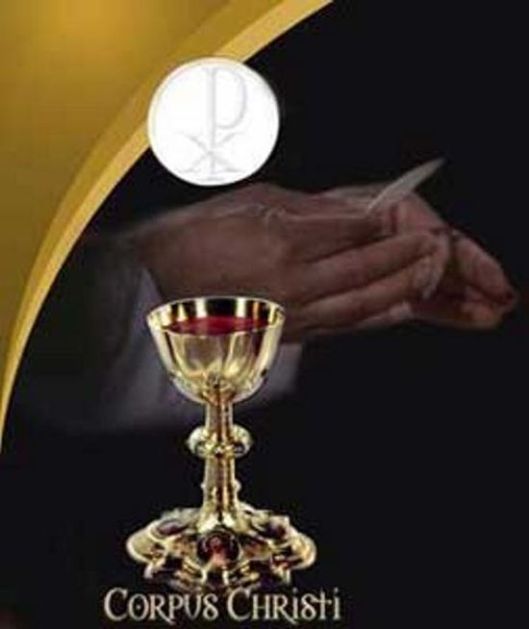
Today is the feast of Corpus Christi, the Body and Blood of Christ. From the beginning, orthodox Christianity has confronted the heresy that denies the Incarnation. In his epistles, St John writes about those who denied that the Christ had come in the flesh, and we know that that line of thought continued – as indeed it does to this day. If Christ was not human, our flesh is not redeemed and our nature is not sanctified; St Gregory of Nazianzus rightly pointed out that: ‘what was not assumed cannot be saved.’ Like St Athanasius and St Cyril of Alexandria, St Gregory fought hard against the gnostic heresy which sees us as ‘spirit’ and our bodies as merely vehicles for that spirit. Yes, we are spirit, but we are also body, and when we are resurrected, it will not be as disembodied spirits, but rather embodied ones – our sinful bodies are made clean by His body, and just as Christ was raised in the flesh – the first-fruits of Redemption, so, too, shall we be raised.
It is that central truth which we celebrate at Corpus Christi – the solemnity of the body and blood of Our Lord Jesus Christ. As today’s Gospel reading shows, what we do at the Mass is what Jesus did at the Last Supper. The Last Supper is not the first Mass, but it does prefigure the Mass. Jesus had told his disciples that he was offering his body and blood for them, and that if they were to be saved, they had to receive these elements. We know, because St John tells us, that some of his followers found this saying so hard – after all the word used in St John is the word for ‘gnaw’ – that despite being in his presence for some time, many walked away. They could not accept the hard saying.
And how shall we? From early on, as early as the first reports of Pliny the Younger, those outside the Church accused its members of a type of cannibalism. Some Christians have preferred to concentrate on the memorialising aspects of the Eucharist, and ignored the fact that Christ says ‘This is my body’ and ‘This is my blood’. St Paul tells us that those who eat and drink ‘unworthily’ do so to their own damnation – not something which one would expect from something that was merely a memorial. To the rationalist and the sceptic, this whole line of doctrine is folly.
Latin theologians of the Middle Ages, confident in their ability to explain even the deepest mysteries (would that we had but a trifle of that boldness) came up with the notion of transubstantiation to explain how the bread and wine could be both His body and blood, but stay, to all appearances, bread and wine. Some Orthodox Christians have found that notion too specific for their tastes, whist some say it is all too time-bound, using, as it does, the language of Aristotelian physics. All of that is a pity if it perpetuates division.
the Real Presence of Our Lord in the consecrated bread and wine is the deepest of mysteries, a perpetual miracle, the continuation of the promise he made that he would be with us evermore. We are made one with him, through him, and in him. It is this we celebrate on this day – and with it, the long continuity in faithfulness with what the Lord taught in the Upper Room, performed at Calvary, and vindicated through the Resurrection. He is with us ever more, even to the end of this world.

It is good to be reminded of this. Personally I don’t think I will ever understand what really happens, but I try to do a few things when taking communion:
1) Think about His suffering.
2) Ask for forgiveness.
3) Think about the covenantal significance behind communion.
We talk a lot about John 6 and the Last Supper, but the covenant with Abraham, when God walked between the carcasses, and the covenant at Mt Sinai are also important as framing pieces.
LikeLiked by 3 people
Indeed so, NIcholas.
LikeLiked by 2 people
Great article. Hope you had a blessed feast of Corpus Christi on Sunday. External Solemnity, that is. 😉
LikeLike